

Some very pleasant weather this week and the English Apple Man attends the BIFGA - AGM and HDC/EMR Strawberry walk
On Wednesday on a warm summer's evening the 27th BIFGA Annual General Meeting was held at Biddenden Vineyards at the invitation of Julien Barnes of Biddenden Vineyards.
The formal AGM attended by circa 50 members, was conducted by BIFGA founder and Chairman John Breach accompanied by his Vice Chairman - Clive Edmed, Treasurer - David Budd and BIFGA Secretary Judi Perry.
Below: L-R: David Budd, Judi Perry, John Breach and Clive Edmed
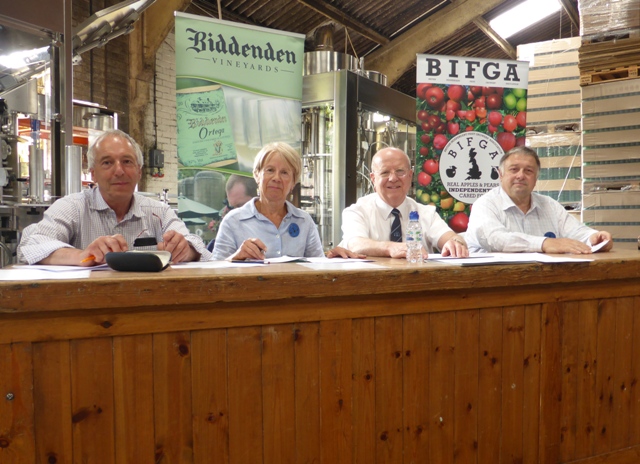
Following the AGM - John Breach introduced David Bishop from ICA who presented the latest information on the research programme into Dynamic Controlled Atmosphere using the ICA 'Safepod' system. David told BIFGA members the new research programme led by ICA in association with fellow consortium members, the University of Greenwich (in association with the Produce Quality Centre at East Malling), AC Goatham and Son, Sainsbury's and Norman Collett Ltd have been awarded funding from The UK's Innovation Agency, Innovate UK to fund a three year research project starting in the Autumn of 2015.
The project is titled 'SafePod: New Technology for intelligent control of fresh produce storage'. This will see the full scale trialing and further development of the SafePod system for UK fruit and growing conditions and determine how best this new technology can be implemented to the benefit of the UK fruit storage industry; exciting times ahead!
Below: David Bishop brings BIFGA members up to date with SafePod
For more information - click on ICA Storage John Breach thanked David Bishop for his presentation and his ICA colleagues present for sponsoring the evening, before introducing Julien Barnes.
Biddenden Vineyards
Before escorting BIFGA members on a guided tour of this truly beautiful vineyard, Julien Barnes gave an extensive overview of his family business: Julien told BIFGA members that Biddenden Vineyard is Kent's oldest commercial vineyard, established by the Barnes family in 1969 to produce wines and ciders. The initial change from top fruit growing into juices and cider influenced by the changing market place for small top fruit growers; the next step into growing grapes and producing wine was the inspiration of his mother who heard a Hampshire grape grower talking on BBC Woman's Hour.
The vineyards are set in 23 acres on a gentle south facing slope in a shallow sheltered valley, 1.2 miles from the lovely Wealden village of Biddenden. Eleven varieties of grapes are grown to produce White, Red, Rose and Quality Sparkling wines. Traditional Kentish ciders have also been made here for over 30 years together with farm pressed apple and pear juices.
Julien said that Ortega (White and Rose) has become their 'signature' speciality wine and in addition to the wines produced, BV also makes a wide range of speciality Ciders and 500,000 bottles of apple and other juices pressed and bottled for other growers.
The leisure side of their business continues to grow, with 'Vineyard and Winery tours, tasting, lunches etc' popular activities for visitors to this very scenic vineyard.
Below: Julien and the young (4 year) Ortega vines - Ortega is grown with 'high quality' wine the objective.
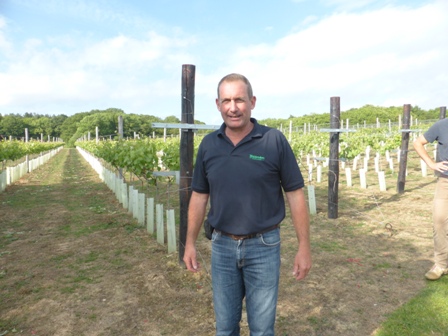
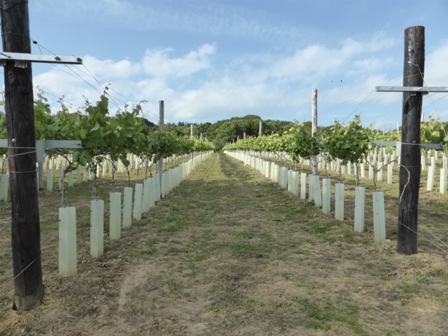
Julien is using a novel system of training the young vines in an S shape format and uses a movable wire system to support the young vines as they grow; the ability to move the wire upwards with the vine is central to this system. Julien also introduced Duncan McNeill and Julien Lecourt; Duncan also has his own vineyard and acts as an advisor to Julien Barnes (and other growers) and Julien Lecourt is now working at East Malling Research (EMR) on viticulture research.
Below: the adjustable 'top wire' and a view 'up the row' between the young vines
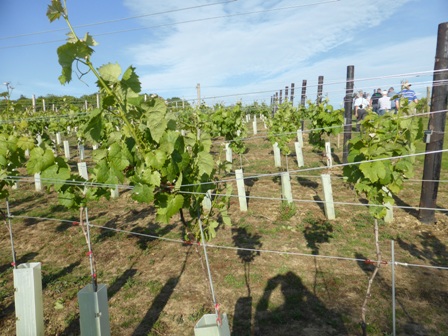
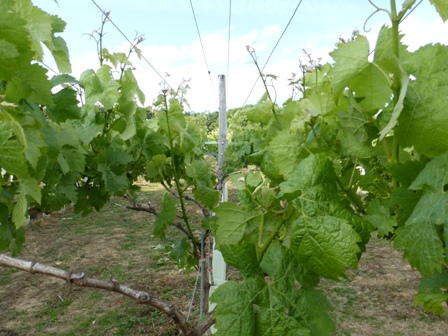
Vineyard Tours are an important aspect of the leisure activities at Biddenden and this informative plan helps visitors on the 'self guided vineyard trail'
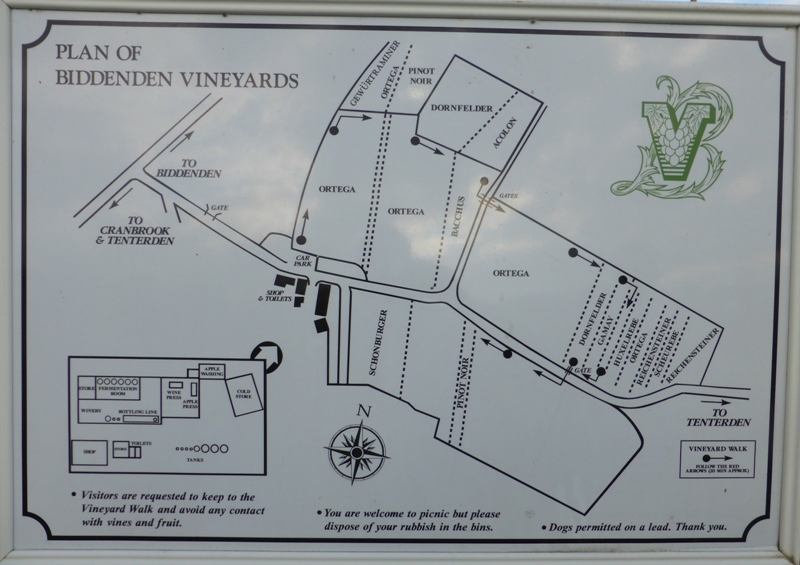
Below: Julien Barnes in 'full flow' on Wednesday evening - his passion for growing grapes and producing wine is a clear reason for the success of Biddenden Vineyards
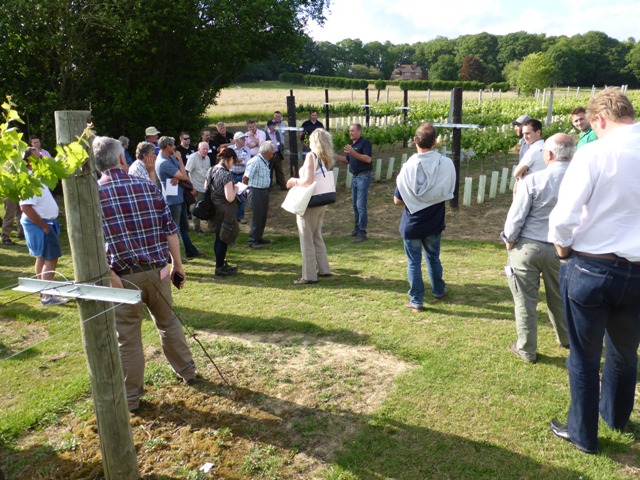
The reputation for English Sparkling Wine has never been higher, but Julien is very proud of the quality of his still wines; the Dornfelder produces a very good red wine (endorsed by The English Apple Man during tasting) all the rows of vines are now 11ft apart. Originally Julien planted them much closer (5 - 7ft) in line with German vines, but in his drive for high quality wine he believes in our climate, a wider spacing allowing the afternoon sun access to the vines improves the sugars and quality of the wine. 'Quality is his mantra'
Below: Dornfelder is the main grape used for Red Wine (Gamay is also used in vintage growing years)
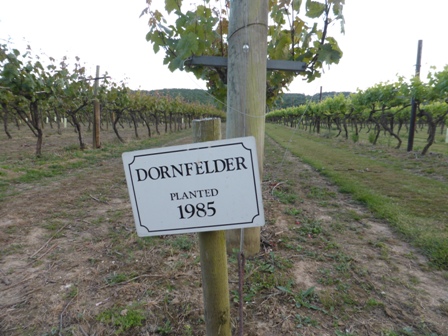
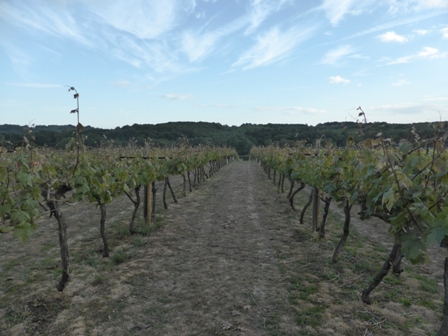
Gamay produces a quality red wine in vintage years, but this has only happened three times in the last 15 years and in most years the Gamay is used for Sparkling Wine.
Below: A panoramic view of Gribble Ridge - the vineyard is very scenic; well worth a visit just for the beautiful setting and surrounding countryside

And on to the wine tasting and an excellent supper - 'thank you ladies!
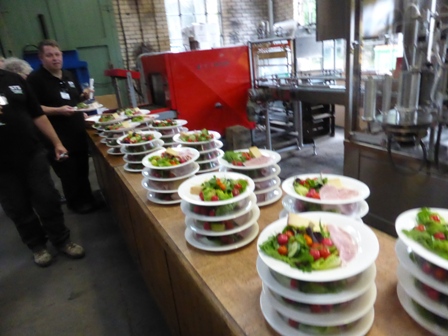
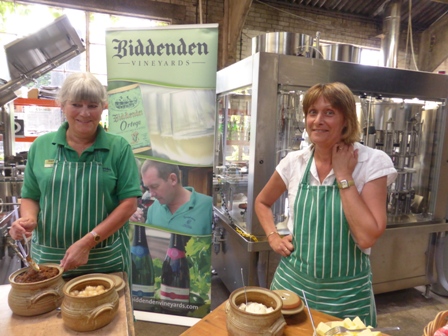
Tucking into supper!
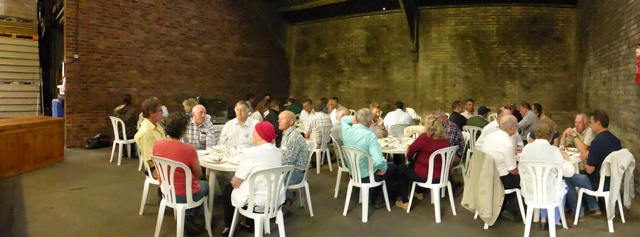
SHOP: Finally, a bottle of Ortega and Dornfelder for 'home consumption by The English Apple Man
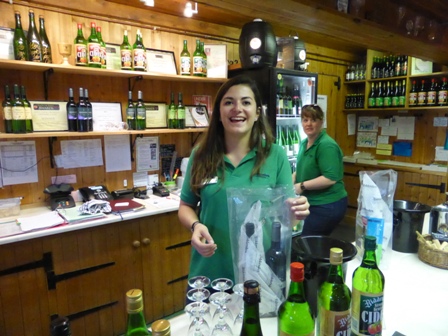
The English Apple Man comments: "much more could be written about Biddenden Vineyards - the technical management is very high and cannot be done full justice in this brief report, however anyone visiting and taking a tour will be able to fully appreciate the skills and vision employed by Julien and his staff!
HDC/EMR Strawberry Walk
This evening allowed interested Strawberry growers and industry representatives (+ some press) an opportunity to view the latest Strawberry selections trialed at EMR by The Strawberry Breeders Club. The Club is made up of industry investors (marketing desks, large soft fruit growers) and is funded jointly by industry (Club members)and HDC.
Adam Whitehouse - EMR strawberry breeder hosted the evening and explained the principles used by the Strawberry Breeding Club. Each year 13,000 new numbered varieties are planted; after one year the 'selection process' takes place - Adam and his team at EMR walk the field identifying promising 'contenders' and whittle them down to about 130 (1%) for planting into the trial site.
Below: Adam Whitehouse with samples of trial varieties for tasting.
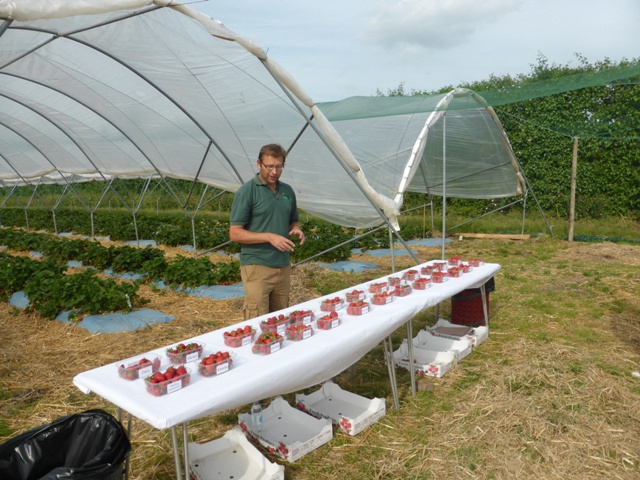
The 130 trial varieties (all numbered) are grown and harvested on a 'twice weekly' basis for tasting and visual evaluation. 'Appearance' (shape, colour, sheen, seed prominence etc) size profile, earliness of cropping is an important factor; not just the first pick but the weight at each pick. 'Taste' (sweetness, texture, firmness, flesh colour etc)
Evaluation is vital to identifying a potential new variety, which must be capable of matching established varieties. The Club Members will play an important part in determining which 'numbered varieties' may go forward for further trials. A new Strawberry variety must also be trialed by growers using different production systems - e.g. 'Table Tops in peat bags, on ridges under tunnels etc.
Below: trial variety tunnel
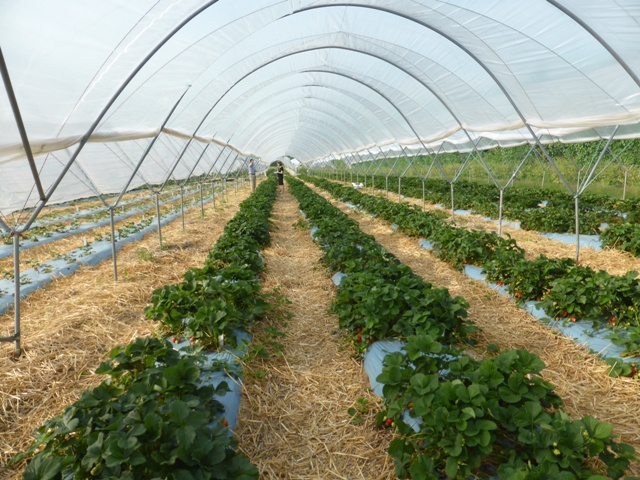
Below: a section of three 'trial' plants
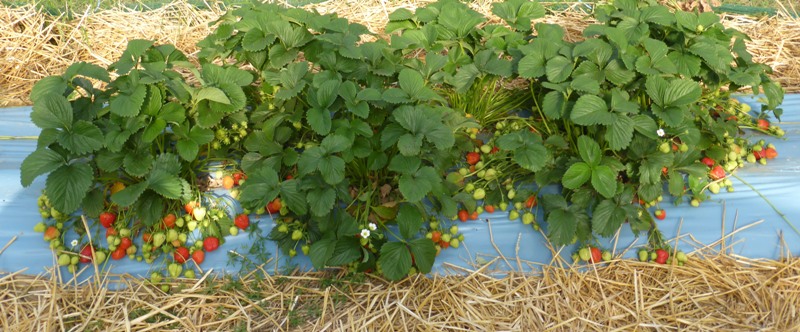
One 'luscious' red berry! - Strawberry samples ready for tasting.
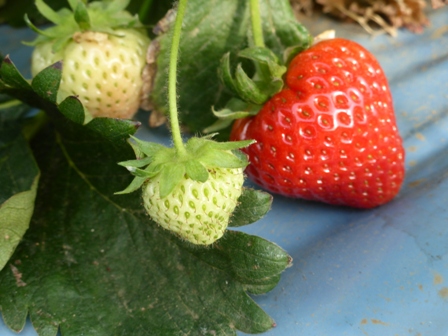
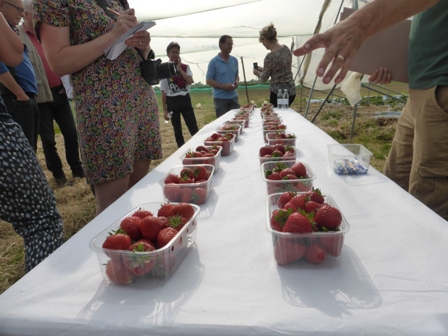
Taste and evaluation is compared with established varieties.
Below: Named varieties - and numbered trial varieties
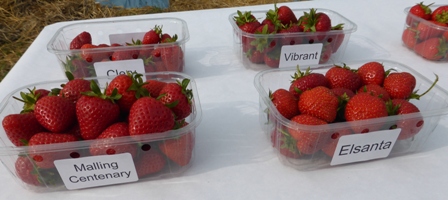
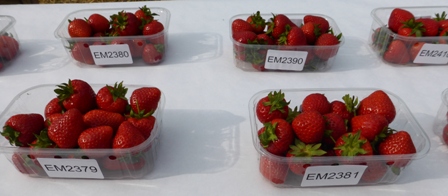
The performance of the variety in terms of yield, visual quality, taste etc is not the only consideration for Adam and his team - the plant must also be capable of producing sufficient 'runners' for commercial breeding, IF the variety is good enough to become a named commercial variety.
Below: a trial plant with good fruiting performance - and a plant with good 'runners' developing!
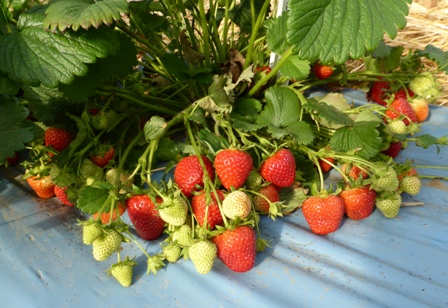
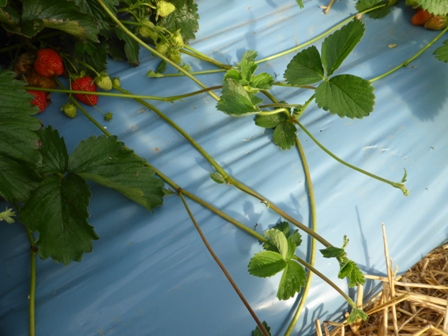
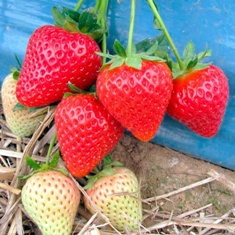 The time span between crating the new variety - 'cross pollinating' by introducing pollen from one variety (flower) onto a second flower in a laboratory situation by the breeder (Adam) and introduction as a new named variety is 7-8 years; and as an example, the variety Malling Centenary - bred by Adam in 2006 has become one of the success stories from the breeding club.
The time span between crating the new variety - 'cross pollinating' by introducing pollen from one variety (flower) onto a second flower in a laboratory situation by the breeder (Adam) and introduction as a new named variety is 7-8 years; and as an example, the variety Malling Centenary - bred by Adam in 2006 has become one of the success stories from the breeding club.
For more information; click on Malling Centenary Strawberry
For more information on East Malling Research - click on; EMR
That is all for this week.......next week The English Apple Man will be visiting Hugh Lowe Farms at Mereworth who have supplied The Wimbledon Tennis Championship with Strawberries for the last 25 years!
Take care
The English Apple Man